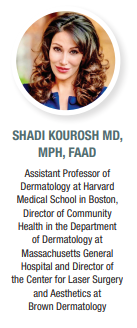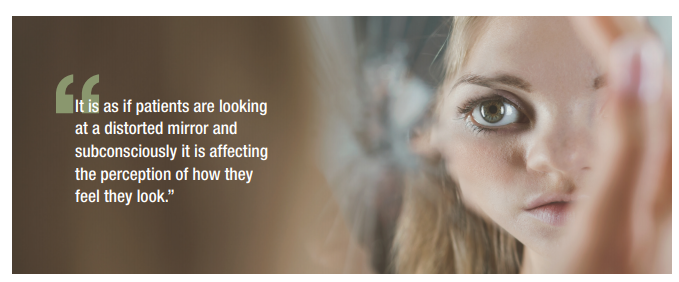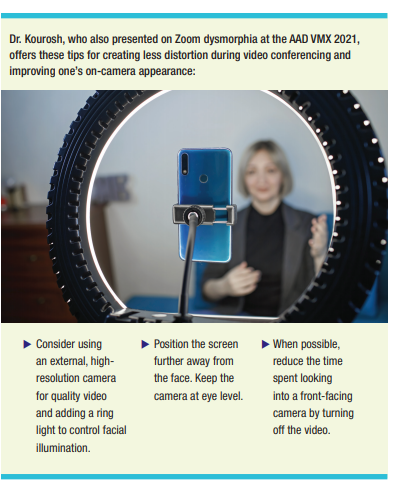With Shadi Kourosh MD, MPH, FAAD

“As aesthetic physicians, we must make sure that if we administer a treatment, we are addressing the actual cause of the problem. If we are not, the treatment that we are offering in the clinic might not be the solution and the patient might still be dissatisfied with their appearance,”
Research for the study “Zooming into cosmetic procedures during the COVID-19 pandemic: The provider’s perspective,” published in the International Journal of Women’s Dermatology, began in 2020 as an observation and conversation among friends and colleagues in dermatology.1
“During the surge of the pandemic, dermatologists were fielding a lot of calls about skin conditions related to the pandemic,” said Dr. Kourosh. “But one that we had not really anticipated was the rise in cosmetic concerns. It seemed unusual to me that at a time of crisis and isolation where people were not even going out in public that we were receiving so many consults and concerns that were related to appearance. I would ask patients what inspired the concerns, many cited video conferences and how they thought they looked terrible.”
Her colleagues said they were seeing the same thing.
The first thing they did was publish their observations in late 2020 an editorial in the Journal of Facial Plastic Surgery.2
“We did this to stimulate discourse in aesthetic medicine around the issue because we were concerned that there might be an element of dysmorphia contributing to this rise in cosmetic consultations,” said Dr. Kourosh. “If so, physicians were going to be fielding these consults and needed to be aware of this.”
With the rise in social media and Instagram filters and apps used to alter people’s appearance, Dr. Kourosh and colleagues were already aware that some people were losing touch with what they actually looked like and, in some cases, what a normal face actually looked like—better known as “Snapchat Dysmorphia.”3 They focused not on filters, but video conferencing technology.
“My research group investigated front-facing cameras used during video conferencing and found that front-facing cameras cause distortions in facial proportions. We surveyed more than 130 members of the Women’s Dermatology Society about what they were seeing. More than 50% of the providers noted a rise in their cosmetic consultations and of that group more than 85% of those providers reported that their patients were citing video conferencing as one of the major reasons for seeking cosmetic evaluations.”

According to Dr. Kourosh, these distortions from front-facing video cameras are subconscious.
“So, the distinction between Zoom dysmorphia and something like Snapchat dysmorphia is that with the photo editing app and filters patients are somewhat aware of the distortion because they are contributing to creating it. But with Zoom dysmorphia we found that the front-facing cameras on devices like smartphones or computers cause certain types of distortions in the proportions of the object that is being viewed, such as the face.”
Dr. Kourosh and colleagues continued their question for answers by further examining the literature.
“We learned that even in classical photography there is a concept of focal distance and distortion that can happen depending on the distance at which an object is photographed.”

And front-face cameras on devices exacerbate this distortion even more.
“But the issue is bigger than we imagined. This phenomenon of Zoom dysmorphia could be a contributing factor to the mental health issues that were noted in the pandemic. Patients are spending hours on end confronting their own images in a way that is unnatural and distorted. I use the example of a fun house mirror. It is as if patients are looking at a distorted mirror and subconsciously it is affecting the perception of how they feel they look.”
There are certain concerns they think are tied to video conferencing.
“People have become very self-conscious about the wrinkles in the upper face and eye area. There also is the issue of lower face skin laxity, where people feel that they were seeing lax, loose skin around the jawline and neck.”
According to Dr. Kourosh, the first step was to raise awareness about the issue and how technology is affecting self-perception.
“We are continuing to study various aspects of this from the patient perspective. There is a lot of data that we have collected that we are still analyzing. We hope this will continue to generate a discourse in our community of dermatology and aesthetic medicine about the holistic care of our patients both from the procedural aspect but also the mental health aspect.
“While the world may be reopening, I think the shifts that we saw during the pandemic to remote work and socializing will likely always remain in some form,” said Dr. Kourosh. “We as physicians in this changing world are going to be called upon to study and guide healthy living in this new normal.”
By Lisette Hilton
References:
- Rice SM, Siegel JA, Libby T, Graber E, Kourosh AS. Zooming into cosmetic procedures during the COVID-19 pandemic: The provider’s perspective. Int J Womens Dermatol. 2021 Jan 12;7(2):213-216. doi: 10.1016/j.ijwd.2021.01.012. PMID: 33937497; PMCID: PMC8072483.
- Rice SM, Graber E, Kourosh AS. A Pandemic of Dysmorphia: “Zooming” into the Perception of Our Appearance. Facial Plast Surg Aesthet Med. 2020;22(6):401-402. doi:10.1089/fpsam.2020.0454
- Ramphul K, Mejias SG. Is “Snapchat Dysmorphia” a Real Issue? Cureus. 2018 Mar 3;10(3):e2263. doi: 10.7759/cureus.2263. PMID: 29732270; PMCID: PMC5933578.
Disclosure : Dr. Kourosh reports no relevant disclosures.

